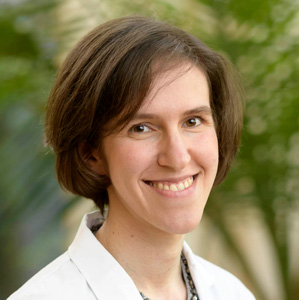
Member Spotlight for October 2021:
Sarah Eskreis-Winkler

Sarah Eskreis-Winkler, M.D., Ph.D.
Breast Imaging Radiologist
Memorial Sloan Kettering Cancer Center
New York, NY, USA
ISMRM Member since 2011
I love MR! It is absolutely amazing, using basic physics principles to design MR pulse sequences and post-processing techniques to investigate an endless array of tissue properties within the human body. I love revisiting the study of human diseases through the lens of an MR engineer: first delving into the details of pathophysiology to identify disease signatures and then thinking about how to use the MR signal equation to design protocols that are sensitized to those signatures in an effort to improve the diagnosis and management of the disease. MR has the potential to address almost any clinical question—it usually just takes some clever thinking and a lot of hard work to make it happen!
In medical school, you get this amazing immersive experience and learn about all aspects of human health and disease. During that process, I discovered that my favorite part of medicine was playing disease detective: using medical clues to sort out a patient’s diagnosis. More often than not, key clues came from the radiology department in the form of x-rays, ultrasounds, CTs, and MRs, and I became increasingly interested in the field of clinical radiology. At the same time, I began to realize that I really wanted not only to take care of patients, but to be deeply involved in improving the current state of medical care through scientific discovery. As physicians, we have these complicated evidence-based algorithms in our heads that help us determine the most prudent diagnostic workup and treatment plans for our patients. You have to be a conservative thinker. But as a researcher, you get to think outside the box and be creative. I love doing that. I started to learn more about the physics behind clinical imaging and became particularly fascinated by MR physics, thanks to several enlightening conversations with Dr. Martin Prince. During my final year of medical school, I began attending Dr. Yi Wang’s Cornell MRI lab meetings and was amazed by his group’s pioneering work to develop a completely new contrast mechanism: Quantitative Susceptibility Mapping (QSM). I ultimately joined the Wang lab as a Ph.D. student and interspersed my years of laboratory work with my diagnostic radiology residency at Weill Cornell Medicine. I was also privileged to train with Dr. Liz Morris at Memorial Sloan Kettering Cancer Center, who inspired me to apply my MRI interests to breast imaging.
I’m a breast imaging radiologist at Memorial Sloan Kettering Cancer Center in New York, where I have been working for a little more than a year after finishing my fellowship training. I divide my time among patient care, research, and education. In the mornings, I help my children get ready for school, and then I bike to work. On clinic days, I spend my time interpreting mammograms, breast ultrasounds, and breast MRIs, as well as performing image-guided procedures. A breast imaging fellow or radiology resident is often assigned to work with me for the day, and so we review the cases together, and I give them teaching points as well as supervise them in procedures. A few times a week, I attend didactic and interdisciplinary conferences where interesting cases are presented and discussed and the medical literature is reviewed. I enjoy these sessions because they help me stay at the top of my clinical practice and because they give me ideas about unmet clinical needs, which fuel my research. On research days, I work on the development of deep learning tools for breast MRI and run an Artificial Intelligence in Breast Imaging lab where I supervise a postdoc and medical student on related projects.
I do my best to finish work on the early side so that I can maximize time with my family in the evening. Once the kids are asleep, I work more on my research at night. I have a wonderful husband and three children, aged 9 years, 6 years, and 18 months. I used to have many hobbies and outside interests. At this stage of life, I am totally focused on raising my kids, spending time with my family, serving as a physician, and building a research lab—though I fully intend to re-embrace my hobbies and other interests at a future stage of life when things are a little less hectic!
My favorite part of ISMRM is the annual conference. It is so exciting and inspiring to see all of the work being done around the world on all aspects of MRI. It is also an amazing opportunity to connect with other researchers working on similar problems, to exchange experiences and lessons learned, and to generate new ideas in the process. I can’t wait to return for an in-person meeting! When I was a Ph.D. student in the Wang lab, the ISMRM conference was our highlight of the year. I joined ISMRM to submit an abstract in 2011 and have been a member ever since!

